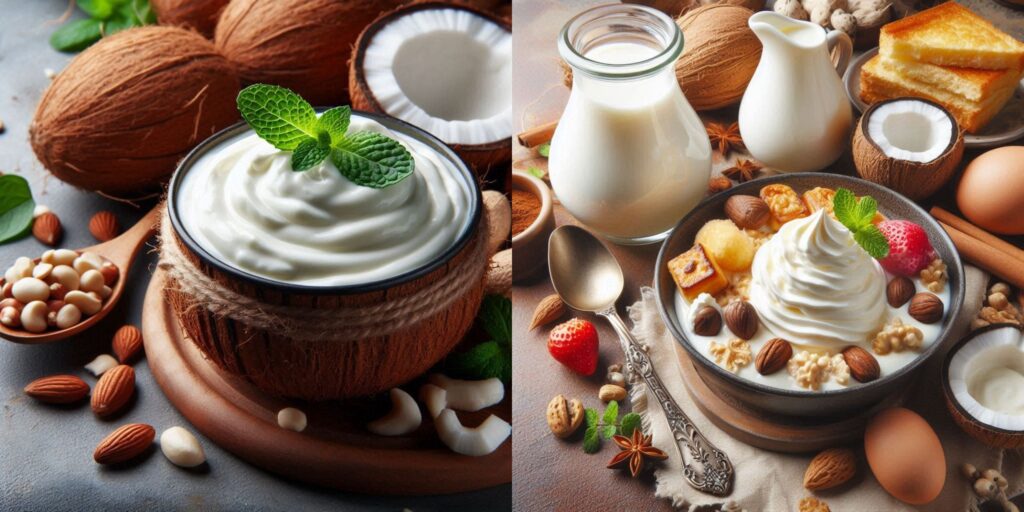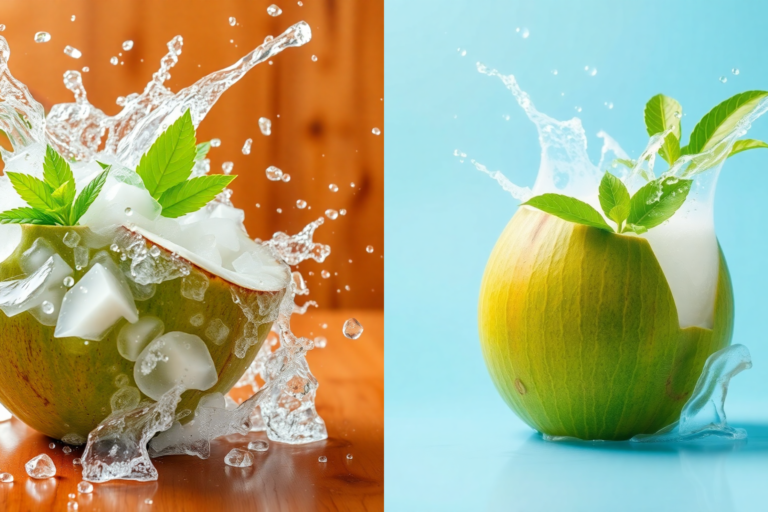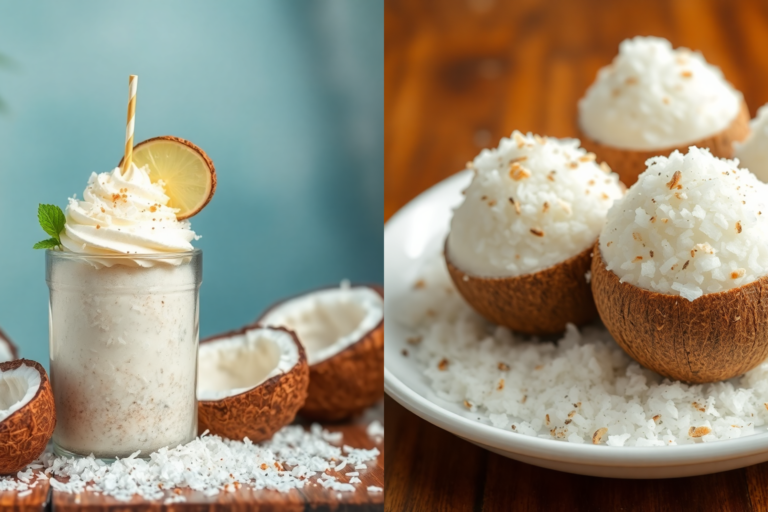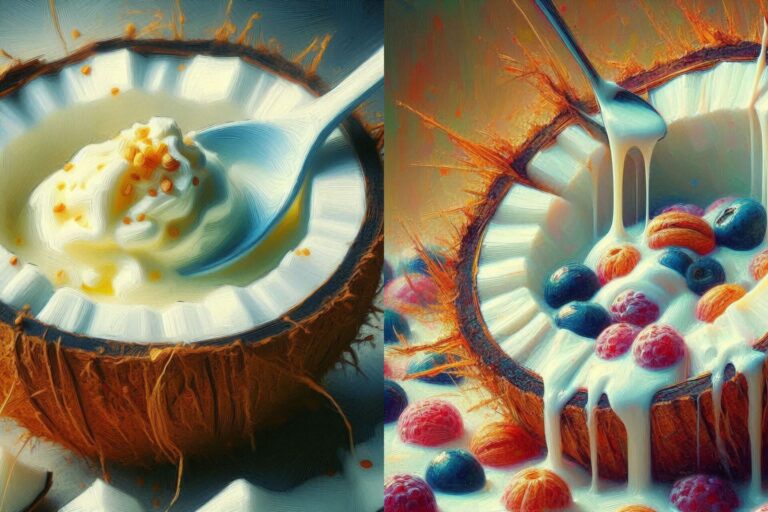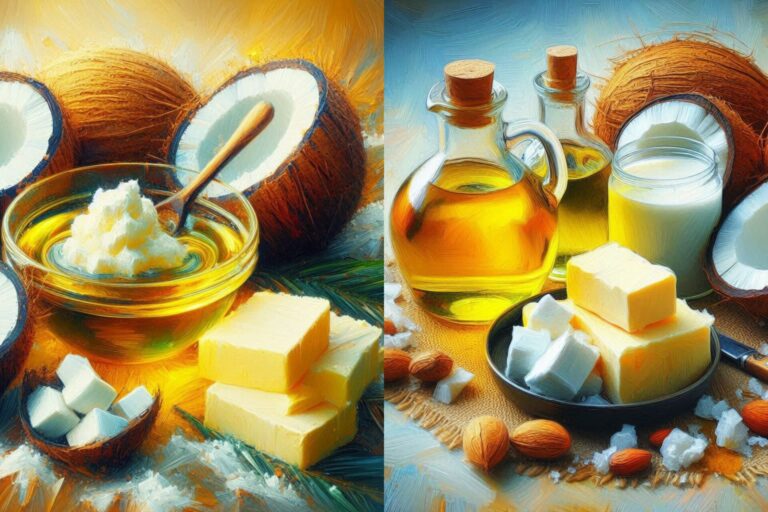Introduction: Evaporated Milk vs Heavy Cream
When exploring the world of dairy products, evaporated milk and heavy cream often come up as versatile ingredients used in a variety of culinary applications. Understanding the characteristics, uses, and nutritional differences between evaporated milk vs heavy cream is essential for anyone looking to make informed choices in their cooking and baking.
Brief Overview of Evaporated Milk vs Heavy Cream
Evaporated Milk: This dairy product is created by removing about 60% of the water content from regular milk. The result is a concentrated milk with a slightly caramelized flavor due to the heating process used during production. It is typically sold in cans and can be used as a substitute for fresh milk in many recipes. Evaporated milk is often chosen for its longer shelf life and ability to enrich recipes with a creamy texture without the fat content of cream.
Heavy Cream: Also known as heavy whipping cream, this is the high-fat part of milk that rises to the top when milk is left to stand. It contains at least 36% fat, which makes it rich, creamy, and ideal for whipping. Heavy cream is often used in recipes where a thick, luxurious texture is desired, such as in sauces, soups, and desserts. Its high-fat content allows it to be whipped into peaks, making it a key ingredient in many confectioneries and baked goods.
Common Uses in Cooking and Baking
Evaporated Milk vs Heavy Cream are both staples in the kitchen but serve different purposes due to their unique properties:
Evaporated Milk: It is often used in recipes that require a creamy texture but not necessarily the richness of cream. Common applications include:
- Baking: It can be used in cakes, muffins, and other baked goods to add moisture and a subtle creaminess.
- Cooking: It is a popular ingredient in sauces, soups, and casseroles, providing a smooth texture without adding excessive fat.
- Desserts: Evaporated milk is frequently used in custards, puddings, and caramel sauces.
Heavy Cream: Due to its high-fat content, heavy cream is ideal for recipes that benefit from its richness and ability to be whipped:
- Whipping: It is commonly used to make whipped cream for desserts, as it can be beaten into soft or stiff peaks.
- Sauces and Soups: It adds a luxurious texture to sauces, soups, and stews, making them creamy and rich.
- Baking: Heavy cream is used in recipes like scones, pie crusts, and rich cakes to enhance the flavor and texture.
Importance of Understanding Nutritional Differences
When choosing between evaporated milk vs heavy cream, understanding their nutritional differences is crucial for both health-conscious individuals and those with specific dietary needs:
Evaporated Milk: With its reduced fat content compared to heavy cream, evaporated milk is often seen as a healthier alternative when looking to cut down on fat. It contains fewer calories and less fat, which makes it a suitable choice for those monitoring their fat intake. Additionally, it provides a good source of calcium and protein.
Heavy Cream: While heavy cream offers a rich, indulgent taste and texture, it comes with a higher fat and calorie content. Its saturated fat content is significantly higher than that of evaporated milk, which may be a consideration for those on a low-fat or heart-healthy diet. However, it also provides a dense source of energy and is rich in fat-soluble vitamins.
By understanding the differences between evaporated milk vs heavy cream, you can make more informed choices that align with your culinary needs and nutritional goals. Whether you’re looking for a lighter option or aiming to indulge in creamy richness, knowing how these two dairy products compare can help you achieve the desired results in your recipes.
Nutritional Comparison 1: Caloric Content: Evaporated Milk vs Heavy Cream
When comparing the caloric content of evaporated milk and heavy cream, it is crucial to understand how each affects your daily caloric intake and overall weight management. Both are dairy products commonly used in cooking and baking, but they have distinct differences in their caloric profiles.
Calorie Count Per Serving of Evaporated Milk vs Heavy Cream
Evaporated Milk: Evaporated milk is a concentrated form of milk with about 60% of its water content removed. It provides a rich, creamy texture with fewer calories than heavy cream. On average, a standard serving of evaporated milk (approximately 1/2 cup or 120 ml) contains about 80 calories. This calorie count may vary slightly depending on the brand and whether it is whole or reduced-fat evaporated milk.
Heavy Cream: Heavy cream, also known as heavy whipping cream, has a higher fat content compared to evaporated milk. A typical serving size of heavy cream (1/4 cup or 60 ml) contains about 205 calories. This higher caloric content is due to the greater amount of fat present in heavy cream, which is around 36-40% fat compared to the lower fat content in evaporated milk.
Impact on Daily Caloric Intake and Weight Management: Evaporated Milk vs Heavy Cream
Daily Caloric Intake: When assessing daily caloric intake, the calorie count of each product plays a significant role.
Evaporated Milk: With approximately 80 calories per 1/2 cup, evaporated milk is a lower-calorie option compared to heavy cream. It can be a good choice for those looking to reduce their overall caloric consumption while still enjoying a creamy texture in recipes.
Heavy Cream: At about 205 calories per 1/4 cup, heavy cream is a much higher-calorie product. Frequent use of heavy cream can lead to a significant increase in daily calorie intake, which may not align with weight management goals for those who are monitoring their caloric consumption closely.
Weight Management: In terms of weight management, the higher caloric content of heavy cream means it can contribute more rapidly to an increase in caloric intake, which may affect weight if not balanced with physical activity or other dietary adjustments. On the other hand, evaporated milk, with its lower calorie count, allows for a reduction in calorie intake while still adding creaminess to dishes.
- Evaporated Milk vs Heavy Cream for Weight Management: Choosing evaporated milk over heavy cream can be advantageous for weight management due to its lower caloric content. By substituting evaporated milk for heavy cream in recipes, you can reduce the overall calorie density of your meals and potentially support more effective weight management.
In summary, when considering caloric content and its impact on daily intake and weight management, evaporated milk offers a lower-calorie alternative to heavy cream. Opting for evaporated milk vs heavy cream can help manage calorie consumption without sacrificing the creamy texture in various dishes.
Nutritional Comparison 2: Fat Content
When comparing evaporated milk vs heavy cream, one of the most significant differences lies in their fat content and composition. Understanding these differences can help in making informed choices based on dietary needs and health considerations.
Total Fat Content in Evaporated Milk vs Heavy Cream
Evaporated Milk vs Heavy Cream: The total fat content in these two dairy products varies considerably, which has implications for both their use in cooking and their nutritional impact.
Evaporated Milk: Evaporated milk is created by removing about 60% of the water content from regular milk. This process concentrates the milk’s flavor and nutrients, but it also reduces the fat content compared to whole milk. Typically, evaporated milk contains about 6-8 grams of fat per cup (240 ml). This fat content includes both saturated and unsaturated fats, but it’s significantly lower than that of heavy cream.
Heavy Cream: Heavy cream, also known as heavy whipping cream, has a much higher fat content. It is made by skimming the top layer of cream from whole milk and has a fat content of around 36-40% by volume. This translates to approximately 80-90 grams of fat per cup (240 ml). Heavy cream contains a higher proportion of saturated fats compared to evaporated milk.
Fat Composition in Evaporated Milk vs Heavy Cream
Evaporated Milk vs Heavy Cream: Examining the fat composition of each product reveals differences in their health implications.
Evaporated Milk: The fat in evaporated milk is lower in total content and generally has a balanced ratio of saturated to unsaturated fats. Because it’s derived from whole milk, it contains a modest amount of saturated fat, but less so than heavy cream. The lower fat content means evaporated milk is less calorie-dense and may be a better option for those seeking to reduce their fat intake.
Heavy Cream: Heavy cream is rich in saturated fats, which are known to impact cholesterol levels. The high-fat content is primarily composed of saturated fats, which can contribute to higher LDL (bad) cholesterol levels when consumed in excess. This can be a concern for heart health, particularly for individuals managing cholesterol levels or those at risk for cardiovascular diseases.
Implications for Health
Evaporated Milk vs Heavy Cream: The differences in fat content and composition between evaporated milk and heavy cream have several health implications.
Health Implications of Evaporated Milk: With its lower fat content, evaporated milk is less likely to contribute to high cholesterol levels compared to heavy cream. It provides a creamy texture and flavor with fewer calories and less saturated fat, making it a preferable choice for those looking to maintain a lower-fat diet or reduce caloric intake.
Health Implications of Heavy Cream: The high fat content in heavy cream, especially the saturated fats, can have implications for heart health if consumed frequently. While it can add rich flavor and texture to dishes, it’s advisable for individuals concerned with heart disease or high cholesterol to consume heavy cream in moderation. Incorporating lower-fat alternatives when possible can help manage overall fat intake.
In conclusion, when comparing evaporated milk vs heavy cream, the key differences in fat content and composition can influence their suitability for different dietary needs and health goals. Evaporated milk offers a lower fat alternative with fewer calories, while heavy cream provides a richer, more decadent option but with higher levels of saturated fats. Understanding these differences can help in making dietary choices that align with individual health objectives and preferences.
Nutritional Comparison 3: Protein Content
Evaporated Milk vs Heavy Cream: Protein Content
When comparing evaporated milk and heavy cream, one significant nutritional aspect to consider is their protein content. Protein is an essential macronutrient that plays a crucial role in various bodily functions, including muscle repair, immune function, and the synthesis of hormones and enzymes.
Protein Levels in Evaporated Milk
Evaporated Milk vs Heavy Cream: Protein in Evaporated Milk
Evaporated milk, a form of concentrated milk with about 60% of its water removed, contains a notable amount of protein. On average, one cup of evaporated milk provides approximately 9 grams of protein. This protein content can vary slightly depending on the brand and whether it is whole or reduced-fat evaporated milk. The proteins in evaporated milk include casein and whey, which are both high-quality proteins that contribute to the maintenance and repair of body tissues.
Protein Levels in Heavy Cream
Evaporated Milk vs Heavy Cream: Protein in Heavy Cream
Heavy cream, also known as heavy whipping cream, is made by separating the fat from milk and typically contains around 36-40% fat. Unlike evaporated milk, heavy cream has a relatively low protein content. One cup of heavy cream usually provides around 2 grams of protein. The primary macronutrient in heavy cream is fat, with protein being a minor component compared to evaporated milk. The lower protein content in heavy cream makes it less effective for meeting daily protein needs.
Role of Protein in the Diet and Its Benefits
Evaporated Milk vs Heavy Cream: Protein Role in the Diet
Protein is a vital nutrient that supports numerous physiological functions. The protein found in evaporated milk contributes significantly to the daily intake needed for:
- Muscle Repair and Growth: Protein is crucial for repairing and building muscle tissue, especially important for those who are physically active or recovering from injury.
- Immune Function: Proteins are involved in the production of antibodies and other immune system components that help protect the body against infections.
- Hormone and Enzyme Production: Proteins play a role in synthesizing hormones and enzymes that regulate various biochemical processes in the body.
- Satiety and Weight Management: Protein-rich foods can help increase feelings of fullness, which may aid in weight management by reducing overall calorie intake.
In comparison, the lower protein content of heavy cream means it offers less contribution to these benefits, making evaporated milk a better choice for those seeking to boost their protein intake.
Evaporated Milk vs Heavy Cream: Conclusion on Protein Content
When evaluating the protein content of evaporated milk versus heavy cream, evaporated milk is the superior choice for those looking to increase their protein intake. Its higher protein levels make it a better option for contributing to muscle repair, immune health, and overall satiety. In contrast, heavy cream, with its higher fat content and lower protein levels, serves a different role in the diet, primarily adding richness and creaminess to dishes rather than contributing significantly to protein needs.
In summary, if protein is a key nutritional focus, evaporated milk offers a more substantial contribution compared to heavy cream. However, the choice between these two products should also consider other nutritional factors such as fat content and overall dietary goals.
Nutritional Comparison 4: Carbohydrate Content
When evaluating dietary options, particularly for those managing blood sugar levels or adhering to low-carb diets, understanding the carbohydrate content of various foods is crucial. In this comparison, we’ll focus on evaporated milk vs heavy cream, specifically examining their carbohydrate contents, and how these differences impact blood sugar levels and suitability for low-carb diets.
Carbohydrate Content in Evaporated Milk vs Heavy Cream
Evaporated Milk vs Heavy Cream: Carbohydrate content in evaporated milk is significantly higher compared to heavy cream.
Carbohydrate Content in Evaporated Milk: Evaporated milk is a concentrated form of milk with about 60% of its water removed. It typically contains approximately 10-12 grams of carbohydrates per 100 grams. These carbohydrates primarily come from lactose, the natural sugar found in milk.
Carbohydrate Content in Heavy Cream: Heavy cream, on the other hand, is much lower in carbohydrates. It generally contains less than 3 grams of carbohydrates per 100 grams. This lower carbohydrate content is due to its higher fat content and lower proportion of milk solids compared to evaporated milk.
Impact on Blood Sugar Levels
Evaporated Milk vs Heavy Cream: The difference in carbohydrate content between evaporated milk and heavy cream has a notable impact on blood sugar levels.
Impact of Evaporated Milk: Due to its higher carbohydrate content, evaporated milk can cause a more significant increase in blood sugar levels compared to heavy cream. The lactose in evaporated milk is a sugar that can be quickly absorbed into the bloodstream, potentially leading to higher post-meal blood glucose levels.
Impact of Heavy Cream: Heavy cream has a minimal effect on blood sugar levels because of its low carbohydrate content. The fats in heavy cream slow down the digestion and absorption of carbohydrates, which helps in maintaining stable blood glucose levels. This makes heavy cream a better choice for those managing diabetes or following a low-carb diet.
Suitability for Low-Carb Diets
Evaporated Milk vs Heavy Cream: When considering a low-carb diet, the carbohydrate content of each product plays a significant role in their suitability.
Suitability of Evaporated Milk: Due to its higher carbohydrate content, evaporated milk is less suitable for low-carb diets. Individuals following such diets often aim to minimize their intake of carbohydrates to maintain ketosis or control their blood sugar levels. Therefore, evaporated milk might not be the ideal choice for those on strict low-carb diets.
Suitability of Heavy Cream: Heavy cream is highly suitable for low-carb diets due to its low carbohydrate content. It provides the richness and creamy texture without adding significant carbohydrates, making it a favored option for those looking to reduce their carb intake while still enjoying creamy foods.
Nutritional Comparison 5: Vitamins and Minerals – Evaporated Milk vs Heavy Cream
Introduction
When comparing evaporated milk and heavy cream, understanding their vitamin and mineral content is crucial for making informed dietary choices. Both ingredients have distinct nutritional profiles that can contribute differently to your daily nutritional needs. This section delves into the key vitamins and minerals found in each, examining how they compare and their overall contribution to a balanced diet.
Key Vitamins and Minerals in Evaporated Milk vs Heavy Cream
Evaporated Milk
Evaporated milk is a concentrated form of milk with about 60% of its water content removed. This process results in a nutrient-dense product with a unique vitamin and mineral profile.
- Calcium: One of the standout nutrients in evaporated milk is calcium. It is essential for maintaining strong bones and teeth, nerve function, and muscle contraction. A 1-cup serving of evaporated milk typically provides about 30% of the daily recommended intake of calcium.
- Vitamin D: Often fortified with vitamin D, evaporated milk helps enhance calcium absorption in the body. Vitamin D is crucial for bone health, immune function, and overall cell growth. A cup of fortified evaporated milk can contribute around 20% of the daily recommended intake of vitamin D.
- Other Nutrients: Evaporated milk also contains smaller amounts of potassium, vitamin A, and vitamin B12, which contribute to various physiological functions including cardiovascular health and red blood cell formation.
Heavy Cream
Heavy cream, known for its rich texture and high fat content, also offers a different set of vitamins and minerals.
- Vitamin A: Heavy cream is a good source of vitamin A, which is vital for maintaining healthy vision, immune function, and skin health. A 1-tablespoon serving of heavy cream provides about 10% of the daily recommended intake of vitamin A.
- Calcium: While not as high in calcium as evaporated milk, heavy cream still contributes to calcium intake. A 1-tablespoon serving provides approximately 3% of the daily recommended calcium intake.
- Other Nutrients: Heavy cream contains small amounts of vitamin D and vitamin K2, which play roles in bone metabolism and blood clotting, respectively. It also provides some vitamin E and phosphorus, contributing to overall nutritional balance.
Overall Contribution to Daily Nutritional Needs – Evaporated Milk vs Heavy Cream
Evaporated Milk
Evaporated milk stands out for its higher calcium and vitamin D content compared to heavy cream. This makes it a valuable addition to the diet for those needing extra support for bone health and immune function. Its nutritional profile supports daily calcium needs more effectively and aids in the prevention of deficiencies related to bone density and immune health.
- Calcium Contribution: With its significant calcium content, evaporated milk is a strong choice for maintaining bone health and supporting metabolic functions.
- Vitamin D Role: The added vitamin D in fortified evaporated milk enhances calcium absorption, making it particularly beneficial for individuals with limited sun exposure or those at risk of osteoporosis.
Heavy Cream
Heavy cream, while not as rich in calcium and vitamin D, provides substantial amounts of vitamin A, which is essential for vision and immune health. It also delivers fat-soluble vitamins and a small amount of calcium, contributing to overall nutrient intake.
- Vitamin A Contribution: The vitamin A in heavy cream supports various functions, including vision health and immune response. It is particularly beneficial for those who need a higher intake of this nutrient.
- Calcium Content: Although lower in calcium compared to evaporated milk, heavy cream still contributes to the daily intake of this important mineral, making it a supplementary source in a balanced diet.
Conclusion
In the nutritional comparison of evaporated milk vs heavy cream, both have their unique benefits. Evaporated milk excels in providing calcium and vitamin D, supporting bone health and calcium absorption. In contrast, heavy cream offers a rich source of vitamin A and a moderate amount of calcium, which supports vision and immune health.
When choosing between evaporated milk and heavy cream, consider your specific nutritional needs. If you require higher calcium and vitamin D, evaporated milk is the better choice. If you need more vitamin A and enjoy the rich taste of heavy cream, it can complement your diet while providing essential nutrients.
Incorporating either into your diet can help meet different nutritional needs, depending on your health goals and dietary preferences.
Conclusion: Evaporated Milk vs. Heavy Cream
When deciding between evaporated milk and heavy cream for your recipes or dietary needs, it’s important to understand their key nutritional differences and how they can impact your health and cooking. Here, we provide a detailed comparison to help you make an informed choice.
Summary of Key Nutritional Differences Between Evaporated Milk and Heavy Cream
Evaporated Milk vs. Heavy Cream: Both evaporated milk and heavy cream serve as versatile ingredients in cooking, but they have distinct nutritional profiles that affect their use.
Caloric Content: Heavy cream is significantly higher in calories compared to evaporated milk. A typical serving of heavy cream contains about 50 calories, whereas evaporated milk has roughly 30 calories per serving. This difference is crucial for those monitoring their calorie intake.
Fat Content: When comparing evaporated milk vs. heavy cream, heavy cream has a much higher fat content. Heavy cream contains around 5 grams of fat per tablespoon, with a substantial portion being saturated fat. In contrast, evaporated milk has a lower fat content, about 2.5 grams per tablespoon, and less saturated fat. This makes evaporated milk a lighter option for those aiming to reduce fat intake.
Protein and Carbohydrates: Evaporated milk provides a moderate amount of protein (about 2 grams per tablespoon) and carbohydrates (around 3 grams per tablespoon), which can be beneficial for maintaining muscle mass and energy levels. Heavy cream has minimal protein and carbohydrates, primarily offering fats.
Vitamins and Minerals: Both ingredients offer nutritional benefits. Evaporated milk vs. heavy cream shows that evaporated milk is a good source of calcium, potassium, and vitamin D. Heavy cream contains vitamin A and some vitamin K2, but it lacks the fortification found in evaporated milk.
Considerations for Choosing Between Evaporated Milk and Heavy Cream
Choosing between evaporated milk and heavy cream depends on your dietary needs and cooking requirements:
Dietary Needs: For those looking to lower calorie and fat intake, evaporated milk is the preferable choice. It offers a lighter option with added nutrients like calcium and vitamin D, making it suitable for those managing weight or heart health.
Cooking Requirements: In recipes requiring a rich, creamy texture, heavy cream is often the better option. Its higher fat content provides a luxurious consistency and flavor, ideal for sauces, soups, and desserts. On the other hand, evaporated milk can be used as a substitute to reduce fat while still achieving a creamy texture in many recipes.
Flavor Profile: Heavy cream imparts a rich, velvety taste, enhancing the overall flavor of dishes. Evaporated milk vs. heavy cream in terms of flavor reveals that evaporated milk has a more subtle, slightly caramelized flavor, which can be advantageous in certain dishes where a lighter taste is desired.
Tips for Incorporating Each into Recipes for Balanced Nutrition
Evaporated Milk vs. Heavy Cream: Here are some tips for using each ingredient effectively to balance nutrition and achieve desired culinary results:
Incorporating Evaporated Milk:
- Soups and Sauces: Use evaporated milk to add creaminess to soups and sauces without the added fat of heavy cream.
- Baking: Replace heavy cream with evaporated milk in baked goods to lower the fat content while maintaining moisture and texture.
- Smoothies and Shakes: Use evaporated milk in smoothies for a lighter, yet creamy texture.
Incorporating Heavy Cream:
- Desserts: Utilize heavy cream for rich, indulgent desserts such as custards, ice creams, and whipped toppings.
- Sauces and Dressings: Incorporate heavy cream into sauces and dressings to achieve a thick, creamy consistency and rich flavor.
- Coffee and Tea: Add heavy cream to coffee or tea for a decadent, creamy experience.
By understanding the nutritional differences and practical applications of evaporated milk vs. heavy cream, you can make choices that align with your dietary goals and enhance your culinary creations. Whether aiming for a lighter, nutrient-rich option or a rich, creamy addition, both ingredients have their place in a balanced diet.
